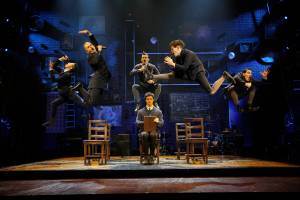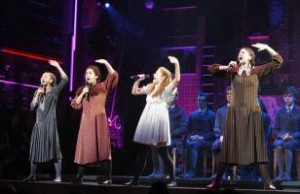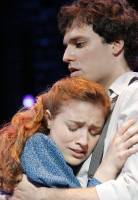
The arrival of Spring Awakening at the Orange County Performing Arts Center is welcome news indeed for anyone who missed the Tony-winning smash in its initial Los Angeles run a year ago. It’s equally exciting news for Spring Awakening fans like myself who simply couldn’t get enough of the Steven Sater/Duncan Sheik musical adaptation of Frank Wedenkind’s groundbreaking 1891 drama the first time around.
The original German play broke plenty of ground indeed with its depiction of on-and/or-offstage masturbation, child abuse, bondage, rape, abortion, and suicide among 14-year-olds just now awakening to their sexuality. No wonder Wedenkind’s late nineteenth-century shocker wasn’t staged on Broadway until 1916 and ended up closing after a single performance.
Very much a groundbreaker in its own way, Sater and Sheik’s musical has proved considerably more successful than its source material, winning eight Tonys including Best Musical, Book, and Score. Following nearly 900 performances on Broadway, the First National Tour is now beginning its second year of introducing audiences across the country to one of the most thrilling, innovative evenings of musical theater since Rent revolutionized Broadway in 1996.
Spring Awakening (The Musical) follows Wedekind’s storylines, though thankfully not too much to the letter. (A non-musical version reviewed here last year revealed the original drama to be both stilted and perplexing.) There are its two teen heroes, the handsome, popular, self-confident Melchior and his introverted, inhibited, wet-dream-plagued classmate Moritz, and its heroine, the all-too-innocent but no less sexually inquisitive girl-next-door Wendla. There are also Melchior and Moritz’s ever-horny classmates and Wendla’s equally randy girlfriends. A pair of older actors stand in for all the adults in these teens’ lives.
What makes Spring Awakening work so brilliantly is not just Sater’s streamlining of Wedekind’s melodramatic plot threads. Singer/songwriter/pop star Sheik’s catchy alternative rock score, the likes of which has probably never before been heard on a Broadway stage, and Bill T. Jones’ brilliantly innovative choreography have together turned Spring Awakening into a mainstream (and cult) international phenomenon.
For this reviewer, the magic in Spring Awakening begins when the mikes (or mics, if you prefer) come out. The show begins quietly, with sexually burgeoning Wendla (Christy Altomare) wondering if she’ll ever be told the truth about man-woman relations in “Mama Who Bore Me,” followed by a very funny sequence in which her highly embarrassed mother (Angela Reed) avoids the question entirely, an omission which proves ultimately disastrous. The song takes on a rock beat as Wendla’s girlfriends join her in a reprise, mikes in hand, but it’s a bit later that the hand-mikes begin to take on a life of their own.
Melchior (Jake Epstein) and Moritz (Taylor Trensch) are in Latin class, the former attempting to rescue the latter from the ire of their monster of a teacher (John Wojda), when the burning need to express what’s going on inside their minds and bodies suddenly erupts. As the first chords of “The Bitch Of Living” sound from the onstage band, Melchior draws from within his school uniform a previously-hidden mike, a gesture so defiant (and unexpected) that at that precise moment I became a Spring Awakening fan for life.
Jones’ Tony-winning choreography then makes its first major appearance, and what truly amazing choreography it is. Unless you’ve seen Spring Awakening on Broadway or on tour, or caught the televised Tony Awards ceremony in which the original cast performed a PG-13 version of “Totally Fucked,” you’ve never seen anything quite like the stomps and back kicks and leaps and jumps that characterize Jones’ cutting-edge dances. It’s as if every adolescent urge just bursting to break free now finds itself expressed in dance. The most striking illustration of this comes in Act Two’s “Totally Fucked,” which has the entire cast contorting as if their sexual wants and their dissatisfaction with the world around them were ants crawling all over their bodies and driving them insane with desire, anger, and frustration.
Spring Awakening works equally well in its quieter moments, which feature some of Sheik and lyricist Sater’s most memorable compositions. The Pink Floyd-esque “Touch Me,” in which the youthful cast of characters express their desire for intimate physical contact; the anthem-like “I Believe,” which sets the stage for Melchior and Wendla’s lovemaking; and the exquisitely sad “Left Behind,” sung at a funeral for one of the teens are just three among many such songs.
Without these musical numbers, Spring Awakening would simply be an abbreviated version of the play I saw prior to the musical, albeit skillfully abridged by book-writer Sater. With them, it becomes something extraordinary, in which contemporary music makes the struggles of nineteenth-century adolescents seem every bit as relevant to today’s teens as the ones they face on a daily basis, as if twenty-first century souls were inhabiting these long-deceased youths. Melchior, Wendla, and Moritz may have been born in the 1870s, but their dilemmas (like the consequences of Wendla’s insufficient sexual education) still ring true in 2009.
Spring Awakening has been cast young, with many of its performers taking time off from school to tour the U.S., and what a cast of triple-threats it is! Epstein and Trensch have joined the company since last year, and each brings his own qualities to his role, Epstein a sexy darkness to Melchior and Trensch a greater subtlety to Moritz, and both are terrific singers. Most others in the youthful cast remain in the roles they originated, their performances retaining a freshness and spontaneity that belies more than a year of touring. Altomare brings innocence and a glorious soprano to Wendla, Steffi D is a combination of rock star and wood nymph as Ilse, and statuesque Sarah Hunt is a forceful and moving Martha, singing of her character’s sexual abuse in the haunting “The Dark I Know Well.” Gabrielle Garza is a adorably precocious Anna, and the voice which comes out of Kimiko Glenn (who scarcely looks even fourteen) is startling in its size and power. The boys are a sexy, charismatic bunch, with bleach-blond Andy Mientus and virginal-looking Ben Fankhauser (the latter new to the cast) standouts as seducer-and-seduced classmates Hanschen and Ernst. (Their amusing reprise of “The Word Of Your Body” with its boy-on-boy kissing is likely to cause discomfort among certain audience members, but I would advise them to simply get over it.) Anthony Lee Medina and Matt Shingledecker continue their excellent work as mother-fixated Otto and piano teacher-obsessed Georg. Reed and newcomer Wojda make for a very funny pair of schoolteachers, and double effectively as parents and other (supposed) grownups. Krystina Alabado, Justin Scott Brown, Kayla Foster, and Lucas A. Wells provide onstage backup singing, and like swings Chase Davidson and Krista Pioppi and adult understudies David Breitbarth and Kate Hampton cover lead and supporting roles.
Though Southern California audiences are accustomed to seeing some of the finest direction, choreography, musical direction, and design the country has to offer, National Tours like this one allow us to experience the work of award-winning Broadway teams, and Spring Awakening is no exception, beginning with Michael Mayer’s superb direction and Jones’ sensational choreography. A+ too for Sheik’s orchestrations, AnnMarie Milazzo’s vocal arrangements, Simon Hale’s string orchestrations, Kimberly Grigsby’s musical supervision, and conductor Jared Stein’s musical direction. The set designed by Christine Jones features red brick walls covered with hundred-plus-year-old photos and paintings and festooned with multicolored fluorescent lights. A plethora of naked light bulbs hang suspended above the stage, and there are bleachers on either side where a couple dozen audience members sit among cast members. Kevin Adams’ extraordinary lighting makes use of both florescent and incandescent bulbs, at times featuring a single color (like the blood red which illuminates one scene or the breathtaking blue that provides a stunning backdrop for “The Mirror-Blue Night”) or in dazzling combinations. Brian Ronan’s sound design is rock concert ready. Susan Hilferty’s costumes, the design’s sole period element, are every bit of equal caliber.
There will doubtless be socially conservative Broadway Series subscribers for whom Spring Awakening will provide yet one more example that today’s society is abandoning traditional morality, but the negative consequences wrought by just those so-called “family values” are precisely what Spring Awakening has on its mind. Younger and more progressive audience members will eat it up and come back for more, and rightly so. Spring Awakening is proof positive that American Musical Theater is alive and well and in constant growth. It is a show and a production not to be missed.
Orange County Performing Arts Center, 600 Town Center Drive, Costa Mesa.
www.ocpac.org
–Steven Stanley
November 17, 2009
Photos: (l.) Joan Marcus, (c.) & (r.) Paul Kolnik





 Since 2007, Steven Stanley's StageSceneLA.com has spotlighted the best in Southern California theater via reviews, interviews, and its annual StageSceneLA Scenies.
Since 2007, Steven Stanley's StageSceneLA.com has spotlighted the best in Southern California theater via reviews, interviews, and its annual StageSceneLA Scenies.







 COPYRIGHT 2024 STEVEN STANLEY :: DESIGN BY
COPYRIGHT 2024 STEVEN STANLEY :: DESIGN BY